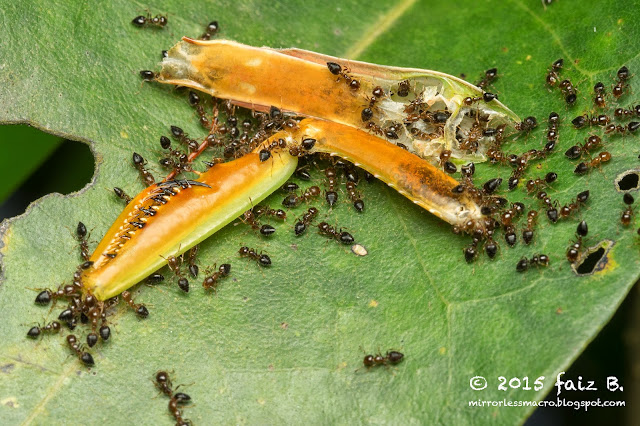Here is a photo update of some of the amazing creatures that I had the privilege of finding during my recent trip to SBWR. Enjoy!
*For a larger image, please click on photo*
1) I was staring at a trail of ants when I caught the sight of this Phyllium Nymph, commonly known as the leaf insect. It blended perfectly into its surrounding and if not for its characteristic swaying motion, I probably would not have been able to spot it in the first place.
2) It was difficult that get a sharp dorsal shot of it because it was simply too 'curvy'! Here you can clearly see what i mean.
3. Another interesting find was this strange-looking Spiny-Back Orb Weaver (Thelacantha sp.)
4. It relaxed after awhile and suspends itself in mid-air.
5) Ventral shot of the Thelacantha sp. I actually find this side of the spider more attractive.
6. This scene actually reminds me of my family when we are out eating crabs. Instead of a crab, these tiny worker ants get to enjoy the remains of a Mantis, devouring it from within the exoskeleton.
7. If you think this is an ant, you're.... half correct! This is actually a female Mymarachne cf. plataleoides, a species of jumping spider (Salticidae) that mimics the Red Weaver ants (Oecophylla smaragdina).
8. Here comes a handsome male with a more pronounced Chelicerae.
9. Check out the tiny waist on the opisothoma! Megan Fox would approve, for sure.
10. The Cephalothorax is also slightly segmented to complete the 'ant look'.
"Hey look at me, I'm an Ant!"
11. Spiders from the genus Mymarachne generally do not eat the ants they mimic. Instead, they use the mimicry for personal-protection as most predators would generally stay away from these formidable ants.
12. Helloo, Handsome. :)
13. Here is another species of spider, from the Family Thomisidae, that mimics the Kerengga ants and unlike the Mymarachne sp., this crab spider ( Amyciaea sp.) actually hunts and eats its role-model ants.
14. Check out the brilliant colours of this Scoliid wasp! Backlit for added effect. :)
15. The same wasp under normal lighting.
16. I have been looking for a female Phintella versicolor for the longest time, and guess who decided to grace me with her presence!
17. Look at the amazing pattern and contrasting colours on her Cephalothorax and Opisthosoma! It is a pretty small Jumper, with a total body span of 6-7mm.
18. Here is a shot of a male Cosmophasis sp. taking a sip of water. If Ernie from Sesame Street was a spider, this would be it. Check out the 'Eyebrows' on this one!
19. This has got to be THE find of the day. No, make it for the whole of 2015. I don't get to see Portias very often but when I do, it is in the middle of hunting down its prey! It was quite a bummer considering how badly I wanted to shoot this Portia cf. labiata, but I am glad that I exercised some self restraint and just let the spider do its own thing as I observe from a safe distance.
20. Portias are recognised to be one of the smartest spiders. It is often dubbed as a 'thinking' spider because of its apparent ability to strategise and formulate the best possible way to get to its favourite meal, the orb-weaving spider, without getting noticed. I only managed two record-shots with my zoom lens as I did not want to intrude into its space and causing unnecessary stress. Such a joy to watch. :)
21. "Crikey, mate! She is a stunner until she opens her mouth to eat you!"
22. The last of the three crocodiles i spotted that day as I make my way out, back into civilisation. A wonderful conclusion to an excellent day of macro photography and nature-watching. :)

















































